Study: Industries with Low Barriers to Entry
Barriers to entry are an important consideration for entrepreneurs entering a market. Among the most significant challenges for a new business are startup costs, government red tape, challenges around hiring employees, and competition from more established companies that have an existing customer base.
 |
This report evaluates the impact each of these barriers has on the 10 most common industries considered by entrepreneurs and assigns them an overall rank.
Among the findings:
- Professional, Scientific and Technical Services is the field with the lowest overall barriers to entry, followed by Construction and then Retail Trade.
- The industry that faces the greatest barriers to entry is Agriculture, Forestry, Fishing and Hunting, followed by Transportation and Warehousing, and then Wholesale Trade.
- Startup costs are lowest for Professional, Scientific and Technical Services, where 38 percent of businesses in this sector start out with less than $5,000. Entrepreneurs in Accommodation and Food Services spend the most; 44 percent of the businesses start out with $50,000 or more.
- Real Estate and Rental and Leasing businesses are the most likely to operate without employees in the early stages, so they are able to avoid barriers to entry related to hiring, training, and creating a payroll system.
- Government red tape is the biggest concern in Transportation and Warehousing, followed by Construction, while it is the least worrisome to Retail Trade companies.
- The sector in which firms are most commonly formed — another empirical low barrier to entry — is Professional, Scientific and Technical Services, followed by Retail Trade. Agriculture, Forestry, Fishing and Hunting companies see the lowest levels of business formation.
The Rankings
| Industry | CreditDonkey Rank | Red Tape | Competition | Startup Costs | Firm Births | Employment Challenges | CreditDonkey Score |
|---|---|---|---|---|---|---|---|
| Professional, scientific, and technical services | 1 | 5 | 4 | 1 | 1 | 3 | 2.8 |
| Construction | 2 | 9 | 1 | 2 | 3 | 3 | 3.6 |
| Retail trade | 3 | 1 | 10 | 3 | 2 | 5 | 4.2 |
| Finance and insurance (combined with real estate and rental and leasing) | 4 | 6 | 2 | 5 | 5 | 6 | 4.8 |
| Real estate and rental and leasing (combined with finance and insurance) | 4 | 6 | 2 | 9 | 6 | 1 | 4.8 |
| Accommodation and food services (combined with administrative support, arts, entertainment and recreation and "other services") | 6 | 4 | 5 | 10 | 4 | 9 | 6.4 |
| Manufacturing | 7 | 3 | 6 | 8 | 9 | 7 | 6.6 |
| Wholesale trade | 7 | 2 | 9 | 7 | 7 | 8 | 6.6 |
| Transportation and warehousing | 7 | 10 | 7 | 6 | 8 | 2 | 6.6 |
| Agriculture, forestry, fishing and hunting | 10 | 8 | 8 | 4 | 10 | N/A | 7.5 |
Professional, Scientific and Technical Services ranked first, reflecting this sector’s low barriers to entry relative to the industries considered. This score takes into account the relatively low monetary startup costs and a large number of firm births in the sector. Construction and Retail Trade followed with second- and third-place rankings for low barriers, although they do face significant issues with red tape and competition, respectively. Finance and Insurance, Real Estate and Rental and Leasing, and Accommodation and Food Services fell toward the middle of the pack, although it should be noted that Accommodation and Food Services come in dead last in terms of financial costs. Three industries – Manufacturing, Wholesale Trade, and Transportation and Warehousing – tied for the seventh spot, just above Agriculture, Forestry, Fishing and Hunting. Those toward the bottom of the rankings face major barriers on several different fronts.
In the following sections, we break down the rankings in each category and discuss the effects each factor has on each industry.
Section 1: Red Tape
For many new business owners, one of their biggest frustrations is dealing with the government. Whether it’s figuring out complicated tax codes or complying with regulations, government red tape presents a particular hurdle for new entrepreneurs who lack the experience and resources of their more established competitors.
For this section, we drew on the National Federation of Independent Business’s (NFIB) 2012 “Small Business Problems & Priorities” report to determine the significance of government-related issues for various industries. The “Red Tape” ranking combines two issues: unreasonable government regulation and tax complexity, as ranked by small business owners. The numbers in the chart show the percentage of owners citing each issue as a “critical problem.”
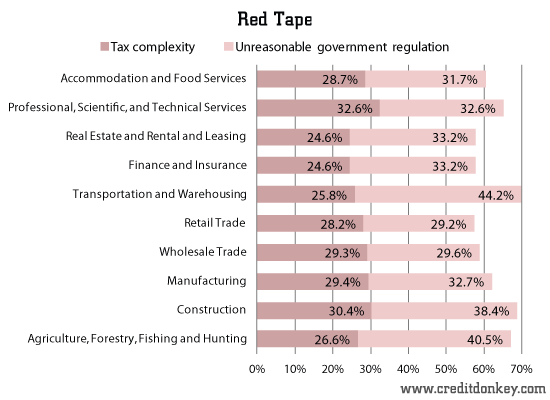 |
| Red Tape © CreditDonkey |
| Source: National Federation of Independent Business, "Small Business Problems & Priorities," 2012 |
The Transportation and Warehousing industry is the hardest hit by regulations, followed by Agriculture, Forestry, Fishing and Hunting and then Construction. Meanwhile, tax complexity is of greatest concern in the Professional, Scientific, and Technical Services sector, followed by Construction.
Section 2: Competition
Competing with other businesses is, of course, a basic fact for any startup. Entrepreneurs go into their new enterprise knowing they need a smarter, leaner, or just plain different approach from their competitors if they are going to succeed. But economies of scale, stable networks of customers, and other factors that tend to give an advantage to larger, more established players hold greater significance in some industries than others.
This section also uses data from the NFIB 2012 survey. Here, we consider the percentage of business owners in each industry who view competition from large businesses to be a “critical problem.”
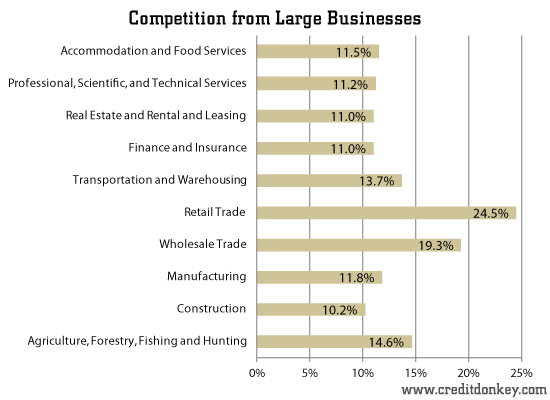 |
| Competition from Large Businesses © CreditDonkey |
| Source: National Federation of Independent Business, "Small Business Problems & Priorities," 2012 |
The industry most affected by larger competitors is Retail Trade, a fact that should not surprise anyone who has followed the rise of big-box stores and their dominance over related mom-and-pop businesses. Wholesale Trade faces the second-most impact from this barrier, followed by Agriculture, Forestry, Fishing and Hunting and then Transportation and Warehousing. The next five industries fall within a percentage point of each other, and Construction comes out the best, with businesses in that field reporting the least concern about this issue.
Section 3: Startup Costs
The cost of starting a business is often one of the first problems a new owner encounters. It is also a hugely variable sum from industry to industry. Some kinds of business require little except a kitchen table and a computer, while others demand a major investment in real estate and equipment.
For this section, we compiled data from the U.S. Census Bureau’s 2007 “Survey of Business Owners.” The figures that follow show the percentage of businesses in each industry started or acquired with less than $5,000, $5,000 to $49,999, and more than $50,000.
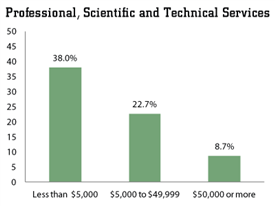 | 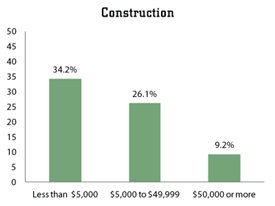 |
 | 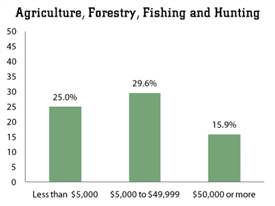 |
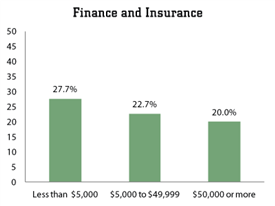 | 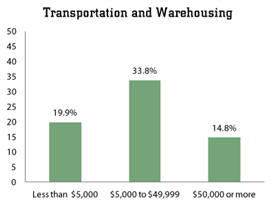 |
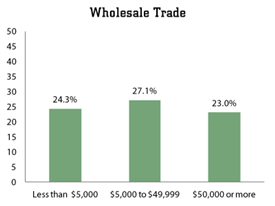 |  |
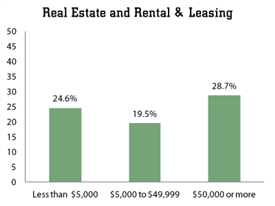 | 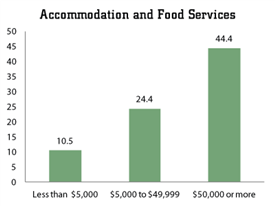 |
Note: Percentages do not add up to 100 because some respondents did not answer or could not answer or recall their startup costs
Professional, Scientific and Technical Services is the lowest-cost industry for businesses entering the marketplace, with 38 percent of businesses started or acquired for less than $5,000 and only 8.7 percent requiring $50,000 or more. Construction and Retail Trade follow with about a third of businesses in each industry starting for less than $5,000, although Construction came out ahead because a relatively large 20 percent of Retail companies take $50,000 or more to start or buy. The most capital-intensive industry is Accommodation and Food Services, where 44 percent of businesses start out with $50,000 or more, followed by Real Estate and Rental and Leasing, and then Manufacturing.
In this section, we ranked the industries using a formula of subtracting the percent of businesses started with $50,000 or more from the percentage using less than $5,000.
Section 4: Employment Challenges
A whole variety of barriers to entry for new businesses revolve around employment. Hiring, firing, and managing employees involves learning complicated regulations. Handling payroll may mean paying a large amount for software or an outside company. In many cases, a business will have to train employees in its specific processes before opening its doors. This means that businesses that can operate without employees will have significantly lower barriers to entry. Even if an entrepreneur intends to eventually expand the business to the point where hiring will be needed, a company that can get started with just an owner’s labor will have a much easier time entering the marketplace.
For this section, we used data from the Census Bureau’s 2007 Economic Census showing the percentage of firms in each industry that are nonemployers.
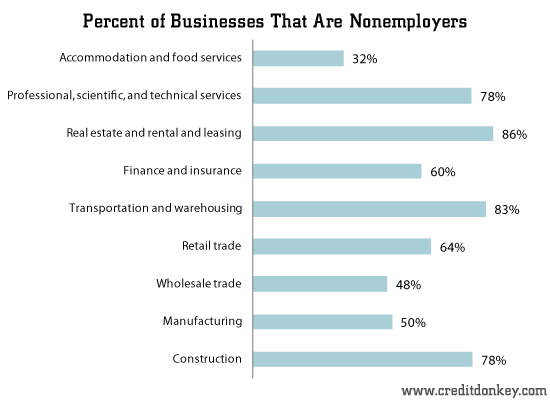 |
| Percent of Businesses That Are Nonemployers © CreditDonkey |
| Source: U.S. Census Bureau, Economic Census, 2007 |
The industries most likely to support nonemployer businesses are Real Estate and Rental and Leasing, followed by Transportation and Warehousing. Construction and Professional, Scientific and Technical Services also have more than three quarters of their businesses operating without employees. By far, the least welcoming industry for nonemployers is Accommodation and Food Services, with the Wholesale Trade and Manufacturing industry also relatively unsupportive to businesses without employees.
Section 5: Firm Births
While the sections so far have identified specific barriers to entry facing new businesses, it would be impossible to evaluate all such challenges. From marketing and customer loyalty to intellectual property, barriers to entry are complex and vary between industries. To provide for a more comprehensive view of the subject, this section provides a general measure of the ease with which new businesses can start based on the total number of firm births recorded for each industry by the U.S. Small Business Administration’s Office of Advocacy for the 2009-2010 period .
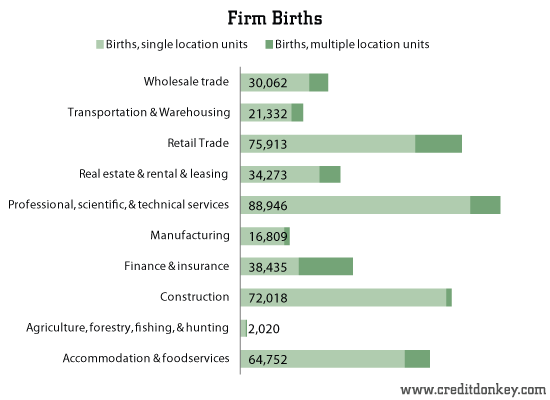 |
| Firm Births © CreditDonkey |
| Source: U.S. Small Business Administration, Office of Advocacy, 2009-2010 |
Here, Professional, Scientific and Technical Services firms stand out as a particularly strong area for startups, followed by Retail Trade, Construction, and Accommodation and Food Services. Agriculture, Forestry, Fishing, and Hunting was by far the weakest sector for firm births.
Conclusion
Barriers to entry are important considerations for any entrepreneur during the beginning stages of exploring a business concept. The industry with the lowest barriers to entry is Professional, Scientific and Technical Services, thanks partly to low startup costs and the relative ease of operating without employees. Construction is also a strong sector for the same reasons, although it faces significant difficulties with government red tape. Other industries balance problems in one area with benefits in others. For example, the Retail Trade sector has little trouble with red tape but faces strong competition from large, established businesses, while Real Estate and Rental and Leasing companies have high startup costs but are relatively easy to operate without employees. New businesses must do their best to consider and balance these factors as they move forward.
CreditDonkey.com provides information on the credit issues, news, and trends facing small business owners through data-driven market research and analysis. Visit our small business blog to stay informed with credit card news, deals, reviews, and tips.
Livia Gershon is a contributing writer at CreditDonkey, a credit card comparison and reviews website. Write to Livia Gershon at livia@creditdonkey.com. Follow us on Twitter and Facebook for our latest posts.






